1967 - Game 7: St. Louis Cardinals @ Boston Red Sox
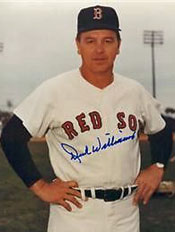
Dick Williams
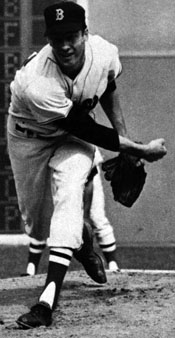
Jim Lonborg

Tony Conigliaro
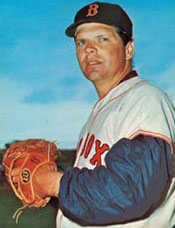
Gary Bell
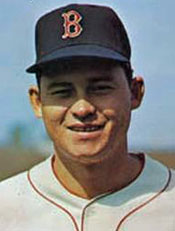
Jose Santiago
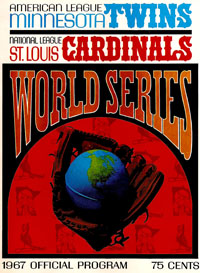
Proposed program cover for World Series that never was; the teams would finally meet 20 years later
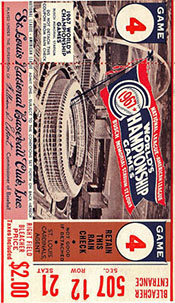

The two men who would be revealed as league MVPs after
the Series, Cepeda and Yaz, before Game 2
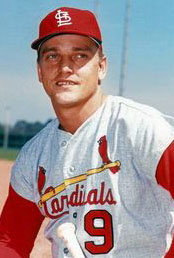
Roger Maris

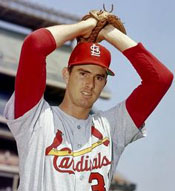
Steve Carlton
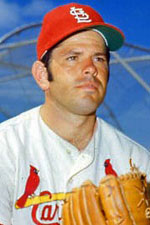
Nelson Briles
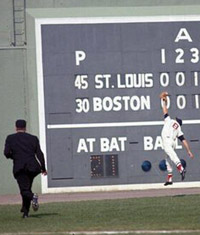
Yaz makes great catch in Game 1.
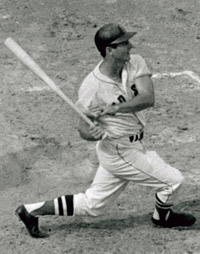
Yaz swats HR in Game 2.

Gary Waslewski
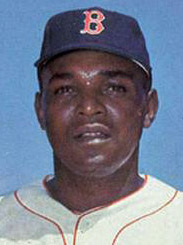
John Wyatt
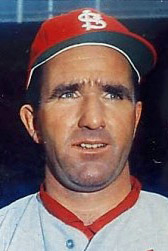
Jack Lamabe
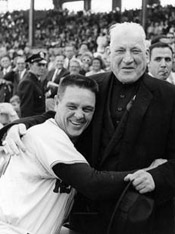
Cardinal Cushing and Dick Williams befoe Game 6

Bob Broeg
|
Pennant Races
The American League staged its most exciting pennant race since 1949.
- As late as September 6, four teams were tied for first:
White Sox 78-61 (.561)
Red Sox 79-62 (.560)
Tigers 79-62 (.560)
Twins 78-61 (.561)
- September 18, Minnesota, Detroit, and Boston had identical 85-66 records with Chicago a half game behind at 85-67.
- Midway through the last week of the season, the White Sox, who had no regular who hit more than .241, finally faltered, losing a doubleheader to the last-place Kansas City Athletics.
- Heading into the last two days of the season, the Twins led both Boston and Detroit by 1 game. Minnesota finished with two games at Boston while the Tigers hosted the Angels for two doubleheaders.
- The Red Sox won Saturday 6-4 to pull into a tie with the Twins. Detroit split to pull within a half-game.
- Boston defeated the Twins Sunday, 5-3. Detroit won the first game over California, 6-4, but with a chance to tie for first, lost the nightcap 8-5.
- So the Red Sox, ninth in 1966 and picked by writers to finish tenth in '67, won their first pennant in 19 years.
After the Tigers lost the second game of the doubleheader to give the Red Sox the pennant, Boston owner Tom Yawkey, who hadn't had a drink in several years, raised a glass of champagne and started to cry.
In his autobiography, Williams summarized his feelings like this: A 100-to-1 shot was going to the World Series. A loudmouth reserve outfielder had led a team to baseball's biggest game of all.
Two men carried the Red Sox in Dick Williams' first year as a big league manager.
- 25-year-old righthander Jim Lonborg, who had gone 19-27 his first two season with the club, exploded to 22 wins, most in the league, against only 9 losses. His 39 starts also topped the AL as did his 246 Ks and 19 HBP. His biggest victory came on the final day, when he outdueled Twins' ace Dean Chance.
- LF Carl Yastrzemski won the Triple Crown: .326, 121 RBI, 44 HR. He also led the league in runs (112), hits (189), OBP (.418), SLG % (.622), and total bases (360). Needless to say, the won the MVP award, garnering all 19 first place votes.
After the pennant-clinching game, Williams told Yaz, who finished the season with 10 hits in his last 13 AB: I've never seen a perfect player, but you were one for us. I never saw a player have a season like that.
- Other key contributors to the Red Sox finishing first in the AL in batting average, runs, doubles, HRs, and slugging % were 1B George Scott (.303, 82 RBI, 19 HR) and RF Tony Conigliaro (.287, 67 RBI, 20 HR). Tony joined Yaz as All-Star game starters. However, Conigliaro was hit in the face by a pitch August 18 and missed the rest of the season.
The '67 Red Sox were one of the first teams to use a video camera to tape players' swings.
- Lonborg was the only standout on a staff that finished 8th in ERA (3.36) and 7th in hits allowed. Only two other hurlers won as many as 12 games, Gary Bell and Jose Santiago, both righthanders.
The Red Sox would face the same club that beat them in seven games in their last World Series in 1946, the St. Louis Cardinals.
- The Cardinals, who called themselves "El Birdos," a name popularized by clubhouse leader Orlando Cepeda (who attributed the monicker to 3B coach Joe Schultz) won 101 games to coast to the flag by 10.5 games over San Francisco and 14 ahead of the surprising Chicago Cubs of Leo Durocher.
Called "one of the most misunderstood players in baseball," Cepeda's career had been resurrected in St. Louis following his trade from the Giants for P Ray Sadecki. Ever since he was Rookie of the Year for San Francisco in 1958, he had been a solid hitter, but he hurt his knee in '65 and started to decline. He became known as a malcontent. Management viewed him as they often viewed Latino players - temperamental and excitable. But the "Baby Bull" (so named because his father, the Babe Ruth of Puerto Rico, was known as "The Bull") thrived with the Cardinals: .325, 111 RBI, 25 HR. They are a great bunch of guys here, and the manager showed me respect ... It's so easy to play here. When I came here I was looking for a new life. We Latins, we like people to appreciate what we do. We live on love. I found love here.
- Red Schoendienst's well-rounded Redbirds finished 2nd in the NL in BA (.263) and runs (695). They led the league in stolen bases with 102, thanks primarily to LF Lou Brock, who pilfered just over half the club's total (52).
Brock recalled: One of the good things about that ballclub was Red actually let us play from Day One. He had probably two meetings that year - if that many. He'd say, "Go get 'em," and we did.
Cepeda, who clashed repeatedly with Giants manager Alvin Dark, also sings Schoendienst's praises. Red let you play ball. Give him 100 percent and he was right behind you. He was a great manager who deserves to be in the Hall of Fame. He figured that we were professional ballplayers, and that we know what to do. He let us play and didn't bother anybody.
- Five of the eight position players returned from the '64 champions. CF Curt Flood led the team in BA (.335) and would also win a Golden Glove Award for the 5th straight season. One of the newcomers, 1B Cepeda, who had been traded by the Giants because he was considered a temperamental Latin prima donna, topped the list in RBI with 111, 34 more than the second-place man, 3B Mike Shannon.
- Shannon moved to 3B from the outfield to make room for RF Roger Maris, obtained from the Yankees in December for 3B Charley Smith in one of the best deals the Cardinals ever made. Though he hit only 9 HRs, the 32year-old Maris, happy to be away from the pressure cooker called the Big Apple, provided veteran leadership and extensive post-season experience.
Schoendienst: Roger said, "Don't worry. If I've got a man on 3B with one out or nobody out, and the infield is back, I'll score him. If I don't hit a long ball or get a base hit, I'll be hitting that ball to the SS or the 2B. He was a helluva fundamental ballplayer, and people really didn't know that about him.
Shannon admits he wasn't thrilled with the prospect of leaving RF. He'd also heard rumors from Maris's time in New York that led Mike to believe the new RF might be a disruptive force on the ballclub. It turned out great for us because we won the pennant in '67 and '68, and Roger was a big part of that.
- The Cardinals finished second in the Senior Circuit in ERA despite the loss of their bell cow, Bob Gibson, from July 17 to September 7 after a line drive broke his shinbone. The 31-year-old righthander still won 13 games with a 2.98 ERA. The surprise leader in wins was 6'3" righty Dick Hughes, who went 16-6 in his first full season in the bigs. 22-year-old Steve Carlton, a southpaw, and 23-year-old Nelson Briles, a righty who did a fine job replacing Gibson in the starting rotation, each won 14.
Gibson wrote in his 1994 autobiography: After eight seasons in the big leagues, I felt by 1967 that I had finally mastered all of my pitches. I could challenge the best hitters with my sailing fastball, induce the double play with my sinking fastball ..., finish off strikeouts with my slider, and do some funky things with the junkball tricks [Bob] Purkey taught me. My control was sharp, and there wasn't a batter in the league who thought he could take the outside corner from me without paying a stiff price.
Schoendienst recalled Hughes's sensational season. He was one of the finest pitchers I ever saw that year. Hughes had great stuff and good control. He and Gibson were just terrific for me.
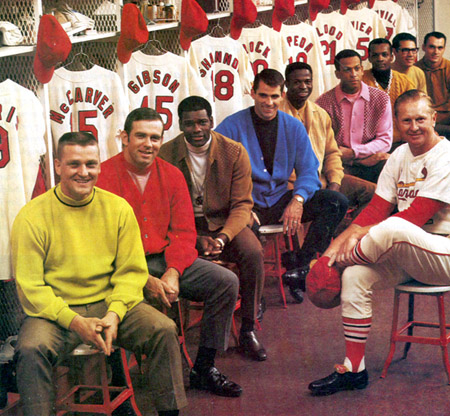
Cardinal starters with manager Schoendienst
Because the AL race went down to the last day with four teams in the running, the Cardinals' traveling secretary tried to make World Series reservations for his club in all the cities. He guessed wrong that Boston would not win. So when Boston took the pennant, all he could get was a closed Sheraton way out in Quincy. Briles recalled: They opened it for us, and the rooms were musty, and there was no food service. We said, "This is a New England plot."
More than 800 reporters from all over the world descended on Boston to cover the series.
- The Red Sox held a lengthy meeting the day before Game 1 to go over the extensive scouting reports on the Cardinals. The Boston scouts could focus solely on the Redbirds the last weeks of the season because St. Louis coasted to the pennant. Williams said, We have a pretty good book on St. Louis.
- The "book" emphasized the tremendous speed of the Cards, led by Brock and Flood. Tim McCarver had above-average agility for a backstop. Even the aging Maris excelled as a base runner.
- While Flood had no rival in tracking down balls - he could crash the wall or pick a line drive off his ankles in short CF, he did not have a strong arm. The Red Sox might take liberties with him on the basepaths when given the opportunity.
- The Sox feared Cepeda, a strong righthanded batter who threatened to pull balls against or over the Green Monster in LF.
- Having started his ace, Lonborg, in Sunday's pennant-clinching game, Williams chose Santiago, a late-season hero, to start Game One against Gibson.
- Veteran Ken Harrelson would man RF. Released by Kansas City August 25, Hawk signed with the Boston three days later when Conigliaro's season suddenly ended and played 23 games down the stretch, driving in 14 runs.
- The Red Sox were nothing if not confident. In his newspaper column, the skipper predicted a Series victory, agreeing with Yaz, who picked Boston in six. Conigliaro joined the chorus in his column.
- Just as in '64 when they faced the Yankees with Mickey Mantle, Maris, Whitey Ford and other household names, the Cardinals felt overshadowed by all the attention given to the "Miracle Red Sox." They respected Boston and their lineup of sluggers. But the Redbirds felt the AL was the slower league, and the NL champs were the more complete team. Unlike Boston, however, none of the Cardinals said so publicly. The cockiness of the Red Sox and their fans only fueled El Birdos' competitive fires.
The Cardinals were particularly disturbed by the ghost written columns in Boston newspapers under the bylines of Yaz and Williams. Yaz picked the Red Sox in six games. Williams guessed five.
- The oddsmakers made St. Louis a 3-2 choice for the Series and an even stronger favorite for Game 1 with the favorable pitching matchup.
One problem for the Bosox was overcoming the feeling that the Series was anticlimactic after their thrilling stretch run. Yaz felt that the final two regular season games had been the biggest of his baseball life. A letdown was almost inevitable. However, Williams rejected such a notion. When asked if he felt pressure, Dick replied, Pressure? You should have been here last weekend. That was pressure. This is fun.
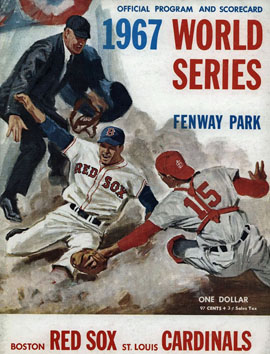 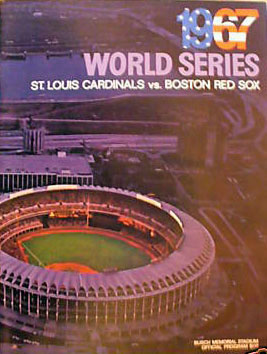
Series Results
- Wednesday, October 4 @ Boston: Cardinals 2 Red Sox 1
WP: Bob Gibson; LP: Jose Santiago
- Thursday, October 5 @ Boston: Red Sox 5 Cardinals 0
WP: Jim Lonborg; LP: Dick Hughes
- Saturday, October 7 @ St. Louis: Cardinals 5 Red Sox 2
WP: Nelson Briles; LP: Gary Bell
- Sunday, October 8 @ St. Louis: Cardinals 6 Red Sox 0
WP: Gibson; LP: Santiago
- Monday, October 9 @ St. Louis: Red Sox 3 Cardinals 1
WP: Lonborg; LP: Steve Carlton
- Wednesday, October 11 @ Boston: Red Sox 8 Cardinals 4
WP: John Wyatt; LP: Jack Lamabe
Gibson and Brock picked up where they left off in the 1964 Fall Classic.
- Bob had won the 5th and 7th games against the Yankees that year. He now mowed down the Red Sox in Games 1 and 4, allowing only one run.
Boston C Russ Gibson recalled: Bob Gibson was more overpowering than I thought he'd be. The first game he struck me out twice, but I didn't feel bad. He got Yastrzemski twice, Rico twice. Punched out ten of us. Heat. And he had a good curveball, too. He was the best pitcher we faced all year, that's for sure.
- Brock had smacked nine hits in '64, including seven in the last three games. In '67, he started sensationally with 4-for-4 in Game 1 with two SBs and two runs scored. Through the first six games against the BoSox, he already had 10 hits in 25 ABs (.400). He also swiped four bases.
The Series grew testy in Games 2 and 3. After Brock's fabulous game in the opener, Lonborg sent him sprawling in his first plate appearance the next day. When the Series moved to St. Louis, Cards starter Nelson Briles nailed Yaz in the left calf on his first AB. That brought Williams running out of the dugout. What's going on? Is this the way it's going to be? Home plate umpire Frank Umont called out Schoendienst who said he'd read in the Boston papers that Red Sox pitchers had thrown at Brock.
- After Santiago pitched well in the opener, losing to Gibson only 2-1, Lonborg threw a one-hitter in Game 2. Then, with the Red Sox down three games to one, he returned to the hill for Game 5 in St. Louis and fired a three-hitter to send the series back to Boston.
Lonborg's feat of allowing just four hits in two games is unmatched in World Series history.
- Just as they beat the Twins the last two days of the regular season to snatch the pennant, the Red Sox were confident they can take Games 6 and 7 and grab the World Series championship.
- Williams took a chance by sending rookie Gary Waslewski to the mound for Game 6. "His legs were shaking," said C Elston Howard. But the veteran of just eight big league starts held the Cards to two runs in 5 1/3 innings. In the meantime the Red Sox set a World Series record by clouting three HRs in a single inning - Yaz, Reggie Smith, and Rico Petrocelli (his second of the game) in the 4th off Hughes. After the Cards tied the game in the 7th, the Sox struck for 4 in the bottom of the inning to set up a repeat of 1946 when it took seven games to settle the issue.
Richard Cardinal Cushing of Boston gave the Red Sox his blessing before watching Game 6 from a box seat alongside the dugout. Would the grace continue to Game 7?
Game 7: Thursday, October 12 @ Fenway Park
Neither manager hesitated when naming a starter for the final game.
- Lonberg, on two days rest, would finally get a shot at Gibson - the dream matchup the country has been waiting for. Each man had surrendered only one run in two complete games in the Series.
- Since Jim usually worked after three days off during the season and Bob enjoyed four rest days between starts, the match could be considered even.
Williams recalled his thinking: I had no choice but to pitch Lonborg on an almost unheard-of two days' rest. Twice before that season he'd pitched with that short a break, winning one and losing one, but in a big game we'd need every inch of him. No matter. I'll be damned if I lose a Game Seven with anybody but my ace. I was praying for one last miracle. He didn't expect his ace to go nine innings but told him to go for as long as he can. The entire staff would be in the bullpen.
Boston P Gary Bell: Of course Dick had to start Jim Lonborg [in Game 7]. He had two days' rest, which normally isn't enough. If Dick hadn't started him, they'd have hung him. It was one of those things that had to be done. There were other pitchers more ready than Lonnie, but because of the year he had and the success he had in the World Series already, Dick had to go with him.
- Williams ordered Lonborg to get dressed and leave the game in the 8th inning of Game 6. "I just wanted him to beat the rush," said Dick.
- After using eight pitchers in Game 6, the Cards needed their ace to go deep into the game.
- The Cardinals franchise was 5-0 in 7th games (1926, 1931, 1934, 1946, and 1964).
- The Red Sox were at their cocky best. The Boston Record-American the morning of Game 7 quoted Williams: My pitching rotation for the final game is Lonborg and champagne. I'm going to listen to those corks pop. Scott predicted, Gibson won't survive five. (Bob later called Scott "a poor imitation of Cassius Clay ...") The Red Sox didn't seem to understand - or maybe didn't care - that such remarks only fueled Gibson's competitive resolve. As Bob recalled, As long as I was with the Cardinals, I don't think we ever wanted to win a game as badly.
- The last time Lonborg started on two days rest, the Indians shelled him in the 2nd the last week of the season.
- Arthur Daley in the New York Times the morning of Game 7: These Red Sox have the never-say-die spirit of the old-time rowdy Cardinals, corny but true. The impossible is their dish and they may even have the momentum to bring to a happy conclusion their own "Mission Impossible."
Gibson went to a jazz club the night before Game 7 but got back to the Sheraton in plenty of time to get a good night's sleep. However, the air-conditioning hadn't been turned on since the Cardinals arrived, and he had a bothersome toothache.
The next morning, he went downstairs to have breakfast. Sitting at the table with his wife, the McCarvers, and the Maxvills, Gibby ordered scrambled eggs. He then watched as everyone else's orders came but not his. When he complained, the waitress brought him some burnt toast. When he told her, "Please take it away," she replied, "We'll take you away."
When St. Louis Post-Dispatch writer Bob Broeg found out on the bus to the park that Gibby hadn't had any breakfast, he hopped off at a stoplight, hailed a cab, and took it to a local diner, where he ordered two ham-and-egg sandwiches that he delivered to the Cardinal hurler in the clubhouse. Gibson: I ate one of them and saved the other. Broeg has always been very proud of the role he played in the 1967 World Series and was crushed to find out years later that I often pitched on an empty stomach. It some ways, it helped to stay hungry.
|
St. Louis Lineup
| Lou Brock |
LF |
| Curt Flood |
CF |
| Roger Maris |
RF |
| Orlando Cepeda |
1B |
| Tim McCarver |
C |
| Mike Shannon |
3B |
| Julian Javier |
2B |
| Dal Maxvill |
SS |
| Bob Gibson |
P |
|
 |
 |
Boston Lineup
| Joe Foy |
3B |
| Mike Andrews |
2B |
| Carl Yastrzemski |
LF |
| Ken Harrelson |
RF |
| George Scott |
1B |
| Reggie Smith |
CF |
| Rico Petrocelli |
SS |
| Elston Howard |
C |
| Jim Lonborg |
P |
|
|
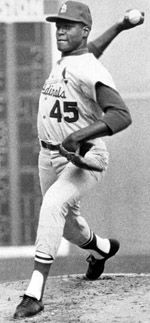
Gibson fires in Game 7.
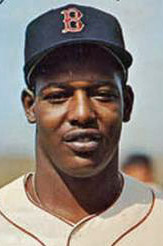
Joe Foy

Mike Andrews
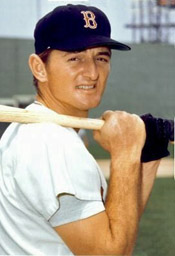
Ken Harrelson
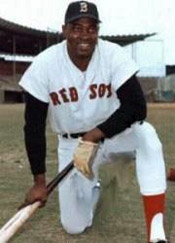
George Scott
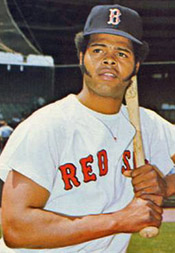
Reggie Smith
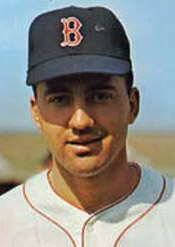
Rico Petrocelli
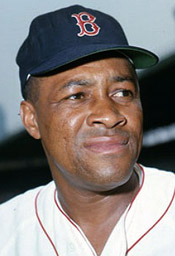
Elston Howard
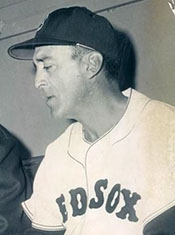
Sal Maglie
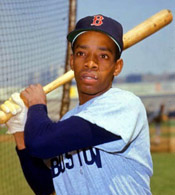
Jose Tartabull
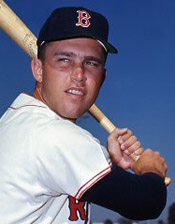
Dalton Jones
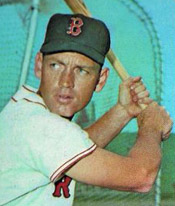
Norm Siebern
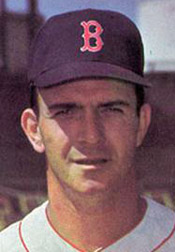
Russ Gibson
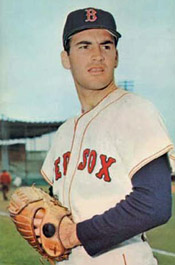
Dave Morehead
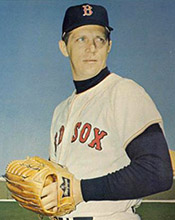
Dan Osinski

Ken Brett
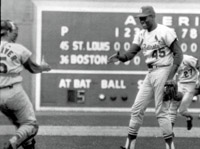
McCarver congratulates Gibson after last pitch.
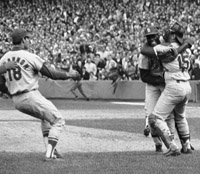
Shannon joins the celebration.
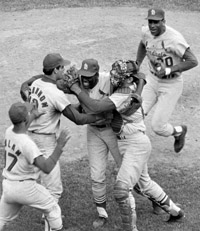
More Cardinals arrive
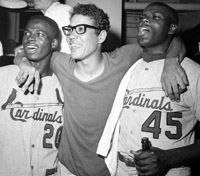
Brock, Javier, and Gibson celebrate the championship.
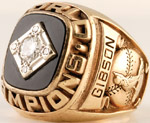
Gibson's World Series ring
|
Despite all of New England praying for rain to postpone Game 7 to give Lonborg another day of rest, the gorgeous Fall weather that had bathed the entire Series continued.
Before the game, Schoendienst huddled with his old pal Stan Musial, now the Cardinal GM, to discuss the lineup. Then Red decided to skip the team meeting he had held every other day during the Series. When asked why after the game, he replied, I had Gibson. I just gave the ball to Gibson.
Ten minutes before the first pitch, Cardinals pitching coach Billy Muffett, who pitched for each of the World Series teams during his career, gave Schoendienst an optimistic report on Lonborg. "I don't think he's nearly as quick as he was the two other times he pitched." Muffett had been warming up Gibson in the adjoining bullpen in RCF and glanced across the railing to check out the opposing starter.
The Red Sox applauded every step their hero
made as he walked in from the bullpen after warming up.
1st inning
- Lou Brock looped the second pitch into the LF corner, but Carl Yazstremski, playing toward CF, ran it down.
Brock had made history in '67, becoming the first major leaguer to smack 20 HRs (21) and steal 50 bases (52) in a season. Schoendienst had given Lou the green light to steal ("unless we were winning by a big margin") all season. Red: He wanted to steal bases, and he knew how to steal bases. He did different things to study the pitchers.
Curt Flood (4-for-25, .150) popped the first pitch to Reggie Smith in CF.
Roger Maris (8-for-23, .343), playing with a shoulder so sore he had to have cortisone shots after each game, had hit a HR off of Lonborg in St. Louis. Roger bounced a grounder up the middle. 2B Mike Andrews backhanded the ball but had no play at 1B.
Orlando Cepeda (3-for-24, .125), standing way back in the batter's box with his 39-ounce 40" bat, bounced out 4-3.
The first four Cardinals batters all confirmed Muffett's assessment of Lonborg - not as sharp as the previous two starts.
- Joe Foy walked on five pitches.
Andrews (4-for-10, .400) bunted down the 1B line. Cepeda tossed to 2B Julian Javier covering 1B.
Would the Cardinals intentionally walk Carl Yastrzemski (9-for-22, .409, with 20 total bases, most of anyone in the Series) in the first inning? The answer was no. The strategy paid off as Gibson jammed Yaz with a fastball that he popped weakly to SS Dal Maxvill.
Yaz had endured a hectic ten days. His parents and his wife's parents stayed at his house which forced him to stay at the Colonial Hotel for home games.
Ken Harrelson (1-for-9, .111) was caught looking on strike three.
2nd inning
- C Tim McCarver popped to SS Rico Petrocelli.
Tim ranked as the second-toughest in the majors to strike out in '67 - just once every 14.7 ABs. Add the fact that he led NL catchers with 67 assists and threw out 55% of would-be stealers and you can understand why the Cardinal backstop finished second in the MVP balloting behind teammate Cepeda.
3B Mike Shannon (5-for-20, .250) swung and missed sidearm curveballs for both strike 2 and strike 3.
Javier (7-for-21, .333), who got the only hit off Lonborg in Game 2, lined a single on one hop to Yaz.
The Cardinals' first Dominican-born player, Javier rebounded in '67 from subpar years in '65 (.227) and '66 (.228). Part of the reason was the arrival of fellow Latino Cepeda. But Julian never had a bad year in the field. He was highly regarded in the NL for his agility and range. Coach Dick Sisler called him a fifth infielder and a fourth outfielder.
With SS Dal Maxvill (2-for-15, .133) at the plate, Lonborg threw to 1B several times to keep the runner close. The Red Sox also pitched out. On a 2-2 pitch, Javier tried to steal, but C Elston Howard, despite the low inside delivery, threw him out, Andrews making the tag.
- Gibson caught 1B George Scott looking with an excellent curve ball.
CF Reggie Smith grounded the 0-2 pitch to Javier.
Petrocelli, in a slump before clouting two HRs on fastballs in Game 6, saw a steady diet of curveballs and fanned.
3rd inning
- Maxvill returned to the plate to start the 3rd. With only one HR all season, and that one inside-the-park, he smashed the ball off the top of the CF wall for a triple. By now, it was clear that Lonborg was laboring.
With the infield in, Gibson smashed a line drive right to 3B Foy. Maxvill got back to the bag.
Brock, 0-for-9 against Lonborg, ran the count to 2-2 before popping up to Petrocelli.
Now a pitch away from wiggling out of the jam, Lonborg surrendered a line single to CF off the bat of Flood to drive home the first run of the game.
Maris smacked the first pitch into RF, sending the runner to 3B.
Jose Santiago got up in the Boston bullpen.
With a chance to retire the side without further damage, Lonborg uncorked a 2-2 pitch that bounced onto the screen. Flood scored, and Maris took 2B. Cepeda then bounced out, 6-3.
The Cardinals now had five hits and two runs, one more of each than they had scored off Lonborg in his previous 18 innings.
St. Louis 2 Boston 0
- Jammed by a fastball, Howard, who had played for the Yankees in the '64 Series, hit a lazy pop to Cepeda.
After receiving a warm hand from the fans, Lonborg took a called third strike.
Working fast as usual, Gibson kept getting ahead of the hitters, mixing an excellent curve with his fastball. Foy fanned on a 1-2 bender, Gibby's fifth victim in three innings.
4th inning
5th inning
- Maxvill grounded out 5-3.
The Boston fans gave Gibson a fine hand as he strode to the plate just as the Cardinal faithful had done for Lonborg in St. Louis. Immediately after radio broadcaster Harry Caray observed that Lonborg looked much better than he had in previous innings, Gibson clobbered a hanging slider over the 379' mark in the extreme LCF corner.
Brock finally got his first hit off Lonborg, a liner in front of Yaz in LF. Now the Cardinals enjoyed flexibility in strategy with Flood coming to the plate.
Schoendienst liked Flood second in the order because he could handle the bat. However, Red recalled: Lou didn't like the hit-and-run. He wanted to steal. So I would tell Flood, if you get the sign to hit-and-run but don't get a good pitch and can see that Lou's getting a good jump, you don't have to hit-and-run.
Santiago resumed throwing in the bullpen as Scott and Howard gathered at the mound.
Brock set sail for 2B on the second pitch. Howard, so anxious to get the ball away, dropped it but probably didn't have a chance to throw out the fleet Redbird anyway. Immediately after Caray observed that Brock rarely stole third, he did just that as Flood took ball four. Lou thus tied the record for most SBs in a Series.
The infield came in at the corners and played DP depth up the middle. On a 3-2 pitch with both runners moving, Maris hit a sacrifice fly to Harrelson in RF. Flood returned to first.
Continuing to struggle, Cepeda popped out to short LF to end a lengthy at-bat.
St. Louis 4 Boston 0
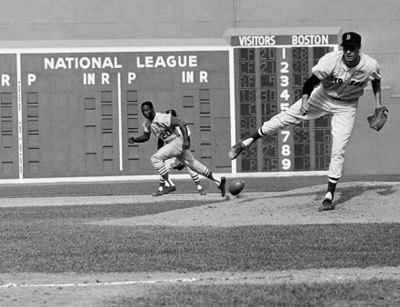
Brock steals 3rd in 5th inning.
- With the crowd roaring encouragement, Scott, the man who predicted Gibson would be gone in five, broke up the no-hitter with a bang, a triple off the 420 mark on the CF wall. When Javier's relay throw skipped past Shannon at 3B into the Cardinal dugout, George continued home.
With the fans excited - "Gibson is human after all. Get 'em Sox!" - Smith flied to RF.
Petrocelli struck out for the sixth time in eight ABs against Gibson.
Howard swung at Gibson's first delivery and popped to Brock in short LF.
St. Louis 4 Boston 1
6th inning
- McCarver hit a low liner to RF. Harrelson dove and caught the ball but lost control when he hit the ground. The batter wound up with a double.
Dan Osinki and southpaw Ken Brett jumped up in the RCF bullpen.
Shannon, 0-for-8 against Jim, hit a vicous smash that Foy knocked down but couldn't make a play on. The scorers gave the Boston 3B an error.
Williams came out to talk to his valiant hurler. The crowd applauded when Dick left the mound without making a change. They would change their tune quickly.
Williams admitted he went to the mound to take out Lonborg so that his star wouldn't take a beating. But Jim wanted to stay, arguing that Javier would be bunting and he could get him. Howard agreed. In his many years of catching, he had never seen anyone who wanted the ball more.
After falling into an 0-2 hole, Javier caught a hanging breaking ball and lofted a high drive off the screen atop the Green Monster. It was Julian's ninth hit of the Series.
Maxvill flied to RF.
Gibson, again receiving applause as he stepped in, went out 5-3.
Brock sliced a liner into the LF corner for an easy double, his 12th safety in the Fall Classic.
Lonborg finally ended the inning by striking out Flood on an 2-2 pitch.
Guessing (correctly) that Lonborg was finished for the afternoon, the fans gave him a standing ovation as he walked to the first base dugout.
St. Louis 7 Boston 1
Lonborg walked off the field devastated with his shoulders slumped, showing his weariness. Tears streamed down his face.
He didn't know how to respond to the ovation. Reaching the dugout, he started to walk up the ramp toward the clubhouse. Williams yelled words of encouragement, and Maglie tried to console him, telling Jim he gave it everything he had. But Lonborg was oblivious. Reaching the clubhouse, he sat in front of his locker and started to take off his uniform, still in tears. He didn't bother to look at the game on the TV because he knew it was over.
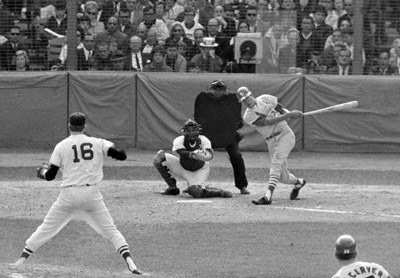
Javier hits a 3-run HR into the LF screen.
- The "Miracle Red Sox" would need a doozy to pull this one out. Fenway is quiet as if everyone is resigned to the fact that the dream is over.
Jose Tartabull, hitting for Lonborg, became Gibson's 9th K.
Foy fouled to McCarver.
Maxvill took Andrews low liner on one hop and threw to first.
7th inning
- Santiago, 0-2 as a starter, took over the pitching duties.
Maris, 10-for-25, got hold of a 1-2 delivery and flied deep to Smith near the wall in LCF.
Cepeda, from Puerto Rico, faced his fellow countryman and went down swinging."
McCarver fouled the first pitch to Foy.
- The crowd rose to its feet, hoping for a Lucky Seventh. With their 3-4-5 hitters coming up, the Red Sox couldn't afford to wait much longer.
Yaz, 2-for-10 against Gibson, drew a full count walk.
Like the St. Louis cleanup hitter, Harrelson had not had a good Series. When the count went to 2-0, Schoendienst came out for a brief meeting with his pitcher. Harrelson hit a slow grounder to Maxvill, who threw to 2B for the forceout.
The crowd came to life as Scott came up - the man with the only hit off Gibson. But George fouled to McCarver.
Smith, 1-for-8 against Gibson, popped to Javier with his back to the infield near the RF line.
8th inning
- Shannon hit the first pitch on the ground to Petrocelli.
A surprise hitting star, Javier smacked a long drive to the warning track in RF where Harrelson made a leaping catch, a fine play by any RF on a ball over his head but especially one not noted for his defensive prowess.
Maxvill popped to Scott in short RF.
- Petrocelli finally solved Gibson, whacking a double into the LF corner.
Dalton Jones, a lefthanded batter, 7-for-18 (.289) in the Series, pinch hit for Howard. The first pitch went to the backstop, sending the runner to 3B and bringing pitching coach Billy Muffett to the mound. After the confab, Gibson, finally showing signs of fatigue, walked Jones on four pitches.
Another lefthanded hitter, Norm Siebern, stepped in for Santiago. With the infield playing back and conceding the run, Norm got an RBI with a slow roller to Javier, who forced Jones at 2B.
Foy hit a squibber off the end of the bat that Cepeda fielded and threw to Maxvill to force Siebern.
On a checked swing, Andrews hit a dribbler down the 1B line that Gibson fielded and threw to first to retire the side.
St. Louis 7 Boston 2
9th inning
- Jones stayed in the game at 3B. Russ Gibson took over behind the plate, and Dave Morehead toed the slab.
After receiving another ovation, Gibson struck out on a curve.
The fans generously applaud Brock, who drew a walk.
Lou took off on the first pitch to Flood and easily stole 2B to set a World Series record of seven. Brock's third steal in the game tied the mark held by Honus Wagner since 1908. Curt then walked.
When Maris, enjoying the best World Series of his storied career with a .385 average and 7 RBIs, also took four balls to load the bases, Williams sent out Maglie to bring in Dan Osinski to face Cepeda.
With one last chance to salvage something in the Fall Classic after driving in only one run with only 3 hits in 28 ABs, Orlando fouled the first pitch to Petrocelli down the LF line.
Maglie walked out and brought in 19-year-old Ken Brett, a southpaw, to face McCarver.
Tim hit .478 in the '64 Series, with a hit in each of the seven games. But he stood at 3-for-23 with 2 measly RBIs in '67. Brett threw one pitch and got a grounder to 1B.

Brock sets World Series record in 9th with his
7th steal.
- As their heroes left the field at the change of inning, the capacity crowd let loose with a deafening roar to thank their heroes for a marvelous season.
Did the '67 Red Sox have one more miracle up their sleeve? They had their 3-4-5 batters coming up.
After receiving a standing ovation, Yaz delivered his 10th hit of the series, a single to RF that put his average at an even .400.
When Gibson fell behind Harrelson 2-0, Schoendienst came to the mound again.
Red told Gibson, You've got a five-run lead. Just get the ball over and make them hit it.
Bob recalled: There was so little left of my fastball that I was mostly throwing sliders. Yaz, who still wouldn't quit, caught one of them for a single ...
Gibby threw a ball, then got a foul to even the count. With the crowd abuzz, Ken hit a tailor-made DP ball to Maxvill: 6-4-3 for what Gibby called "possibly the fastest double play I'd ever seen them pull off."
Gibson finished with a flourish, recording his tenth strikeout. By some sort of poetic justice, Scott was the victim on a 1-2 count.
Final: St. Louis 7 Boston 2
The Red Sox skipper recalled his feelings when the game ended. As we watched the better team celebrate on the field, I forgot for a moment how incredible it was that this 100-to-1 shot got within one game of the world championship. I was too depressed. I didn't look at how far we had come, only at how close we'd gotten. Once again, close was not enough. Only Dick Williams could walk out of a World Series clubhouse feeling like a complete loser.
Mounted police took the field after the last pitch but had almost nothing to do as a lone fan jumped over the railing and stole Cepeda's cap.
Thousands of fans remain in their seats as if reliving the unforgettable moments of the '67 season. A half hour after the game, Yaz's six-year-old son Michael, wearing a blue Red Sox jacket, was still sitting in the family's box before his mother and his grandparents lead him away.
Bob Gibson remains the only pitcher ever to win two Game Sevens. He also tied Red Ruffing of the Yankees with five straight complete-game victories and Christy Mathewson of the Giants for fewest hits (14) surrendered in three Series starts. The Red Sox never managed more than one hit in any of the 27 innings Gibson pitched against them.
|
Postgame
Cardinals Clubhouse
- The small visitors clubhouse in Fenway Park couldn't contain the mob. Anheuser-Busch, owner of the Cardinals, provided washtubs full of champagne. Players sent bottles out to their wives. Joyful Cardinals poured the bubbly on each other and chanted cheers like a football team. One of their ditties was, We're drinking Lonborg and champagne! - a reference to Williams' pregame statement that his pitching rotation was Lonborg and champagne.
- McCarver yelled, It's Gibson's champagne! Then the Cardinal C rubbed it in. This team belittled us in the papers. ... They never should have done that. Now it's our turn to belittle them.
- Flood continued along that line. There was a lot of jazz in the newspapers. I've never seen anything like it in my whole life. Everybody had something to pop off about. They could have finished fourth on the last day of the season. They forgot about that.
- Red Sox owner Tom Yawkey finally made his way into the crowded clubhouse. He grabbed Schoendienst's hand and said, Congratulations! You have a great club, and I hope we can get together again next year.
- Holding a champagne bottle in one hand, Gibson, who had just finished his fifth straight World Series complete game victory, compared this triumph to the one three years earlier against the Yankees. I was tired both times. Today, from the sixth inning on. It's physical. It gets to you all over. I was so tired I could feel it right down to my toes. Lonborg is younger than I am, but he has had one less day of rest than I've had. It should get him before it gets me.
In response to a question, he said,
No, I wasn't thinking about pitching a no-hitter in the early innings. I'm a high, fastball pitcher, and that type doesn't usually get no-hitters. After being informed that he had won the Corvette sports car as Series MVP, Bob recalled the same award three years earlier. In 1964, when I won the car, I was still making payments on my own car. This time, I think turquoise would be a nice color. But Brock should get one, too. He had a hell of a Series.
Gibson would get his wish. When the Cardinals returned to St. Louis, they learned that Robert Hyland, the GM of radio station KMOX, the voice of the Cardinals, would present Brock with an automobile. Hyland said Brock's contribution "was as significant as that of Gibson."
Bob seemed more excited about his four-bagger. I've been waiting all year for that one, he said, flashing his broadest smile of the day.
- McCarver on his battery mate: He's just too much. He goes by sheer guts. When things get tough, he just goes all the way.
- Maris celebrated a World Series championship in a clubhouse other than the Yankees' for the first time. This is a great outfit. They make you feel good just being with them. New York was both good and bad, but it became mostly bad for me. He still resented the circumstances of his departure from the Yanks. Anytime that anybody implies I jaked it or didn't want to play, it's just not true. I was told not to run out infield grounders last year because my knee hurt.
- When asked what the turning point of the game was, Brock thought for a second, then responded, Gibson.
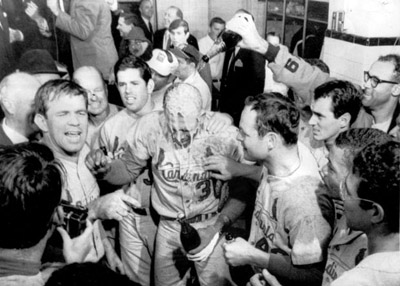
Cardinals douse Cepeda with champagne.
Red Sox Clubhouse
- The champagne on ice went unopened and forgotten. No one touched the victory cakes on the table. Instead, the Red Sox sipped beer and munched on cold cuts and potato chips amid a mood of frustration but not despair. A large platform set up in the clubhouse for postgame TV interviews sits idle. Harrelson wept openly.
- Yawkey went around the room, thanking his men for a great season. He was devastated after the '46 World Series defeat but isn't now. He will always love this '67 team.
- Williams was asked if he made mistake in starting his ace on just two days rest. There is not a thing I've done this season I would have done differently. Lonborg is our best, and we had to have our best today. He wasn't up to par, but he was doing all right. He didn't have his real good stuff. Maybe if he'd had the extra day, he would have. Give Gibson all the credit. If we had got him out, we might have gone to work on their bullpen, but he stopped us. A reporter stuck a microphone in the skipper's face and said, Some people would say you sayed too long with him. Some people would say that, replied Williams icily. Then he calmed down. We played every game we possibly could, but we lost the last one. I was wrong. I said it would be a rotation of Lonborg and champagne. It wasn't. It was Lonborg and beer. But I can speak for every player on the team when I say that we wish we could have won the last one for Mr. Yawkey. And we wish we could have won it for those wonderful fans in Boston. There never has been a year like this one for me, and I guess for any other guy on the team. I hope the people of Boston are as proud of those players as I am. Somehow I think they are.
- Lonborg while soaking his arm in a bucket of ice water: I felt loose but not really strong. With only two days' rest, you find yourself struggling more than you usually do. The strength isn't quite there in your legs, your elbow, and your shoulder. It's a matter of keeping the ball down, but you're just not able to. ... It will take some time to forget this, but I will. To me, this is all part of life. I've learned a lot this year. Now I'm going to put what I've learned together and try to use it to make me a better pitcher next year.
- While Jim thought he had "decent stuff" until the 4th, his C, Howard, felt otherwise. He was coming up with the ball instead of keeping it down. But I never saw a guy bust his gut for a ball club like this guy did. He didn't have that real good stuff, but he tried to give it that extry. The 38-year-old former Yankee said he would talk to Mr. Yawkey and make up his mind after that as to whether he would return for 1968. [He played one more year.]
- Pitching coach Sal Maglie, rumored to be on the firing line since his two-year contract was up, also weighed in on Lonborg: His curve ball was a little flat, but he gave everything he had. That's all you can ask.
- Yaz was philosophical. It's not the ending I'd like to have, but great ballplayers like Al Kaline have never played in a World Series. If we could have stayed close to Gibson, it might have made a difference in the final innings. In a way, it's a great disappointment, but in a way it gives us something to look forward to next season. I'm grateful to be in the World Series, and I know for certain that we have a shot at being in many, many more. [Kaline would play in, and win, a World Series the very next year. Yaz played in one more World Series, the 1975 seven-game loss to the Reds.] Glancing at Lonborg, Carl said, You can't always put heart in your arm.
Red Sox P Dave Morehead recalled years later: Gibson's performance was one of the most amazing things. We saw that firsthand. He was overpowering. I don't think we could have beaten him if we had played ten times.
Gary Bell remembered the '67 Series this way. We took the Cardinals to seven games, and we weren't even supposed to be there. To be honest, being in the World Series was anticlimactic. Getting there was the biggest thrill of all. ... You'd like to win, but going seven games with them was icing on the cake. The fans were proud of us. That was a great year in Boston.
Diminished by the small capacity of Fenway Park, Series attendance totaled 304,085.
- The Cardinals earned an extra $8,315 per man.
- The Red Sox pocketed $5,115 apiece.
That night, a wildly cheering crowd of 15,000 greeted the world champions as they stepped off their plane in St. Louis.
- A line of autos extended back one and a half miles on the highway leading to Lambert-St. Louis Municipal Airport.
- The Cardinals went to a celebration at GM Musial's restaurant. Each Redbird entered "Musial and Biggie's" to resounding cheers from the fans who packed the street. The biggest hurrah was reserved for Gibson.
- Amid the delirium and loud music, Maris remained quiet with his wife at his side. When asked if he would be back next season, he replied, I haven't made up my mind what to do. Added the man who made $75,000 in '67, Money won't help me decide. [He returned and helped the Cards to their second straight pennant.]
The 1967 Cardinals featured the diversity that we take for granted in today's baseball. Two of the starting eight, Brock and Flood, were African-Americans as was the lead pitcher, Bob Gibson. Orlando Cepeda and Julian Javier were Hispanic.
Flood, who would revolutionize baseball with his 1970 lawsuit challenging the reserve clause, told Peter Golenbock years later: The men of that team were as close to being free of racist poison as a divere group of twentieth-century Americans could possibly be. Few of them had been that way when they came to the Cardinals. But they changed. The initiative in building that spirit came from black members of the team. Especialy Bob Gibson. ... Actual friendships developed. Tim McCarver was a rugged white kid from Tennessee and we were black, black cats. The gulf was wide and deep. It did not belong there, yet there it was. We bridged it. We simply insisted on knowing him and on being known in return. The strangeness vanished. ... Friendship was better for the team. ... It was a more potent force than the locker room pranks and other forms of on-the-job congeniality, which had previously been the limits of baseball togetherness. We knew each other's families. ... It was baseball on a new level. On that team, we cared about each other and shared with each other, and face it, inspired each other. As friends, we had become solicitous of each other's ailments and eccentricities, proud of each other's strenghts. We had achieved a closeness impossible by other means.
Gibson wrote in his autobiography: I've never lost my pride in the special, colorless character manifested so uniquely by the Cardinals. Long before Jesse Jackson moved to Washington, we were the rainbow coalition of baseball.
References: The Way It Is, Curt Flood with Richard Carter (1971)
The World Series, David S. Neft & Richard M. Cohen (1990)
No More Mr. Nice Guy: A Life of Hardball, Dick Williams and Bill Plaschke (1990)
Redbirds Revisited: Great Memories and Stories from St. Louis Cardinals, David Craft and Tom Owens (1990)
Lost Summer: The '67 Red Sox and the Impossible Dream, Bill Reynolds (1992)
Stranger to the Game: The Autobiography of Bob Gibson, with Lonnie Wheeler (1994)
The Spirit of St. Louis: A History of the St. Louis Cardinals and Browns, Peter Golenbock (2000)
The Seventh Game, Barry Levenson (2004)
Red Sox Nation: The Rich and Colorful History of the Boston Red Sox, Peter Golenbock (2015)
"Red's Ink," Cardinals Magazine, May 2017
Next in this series: 1968: Detroit @ St. Louis
|
|














































